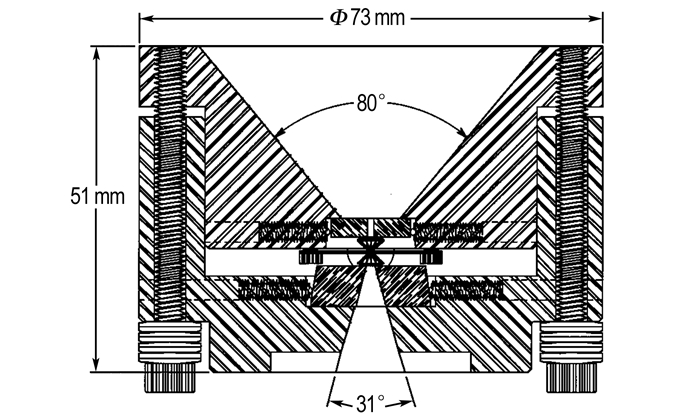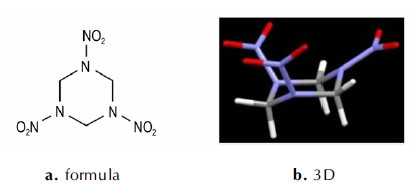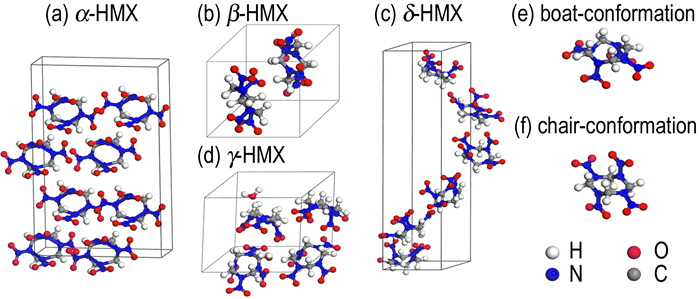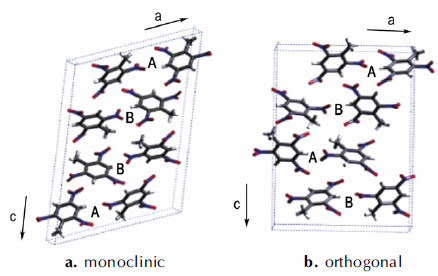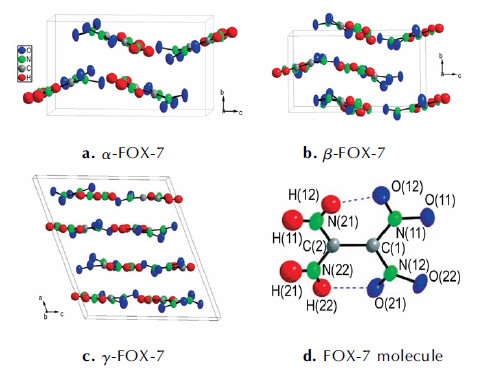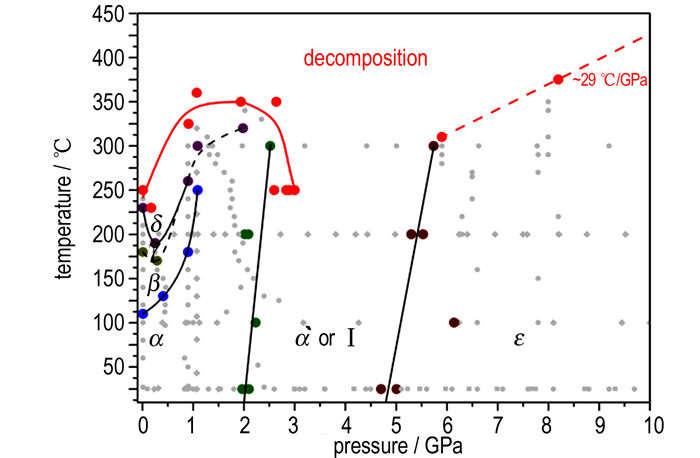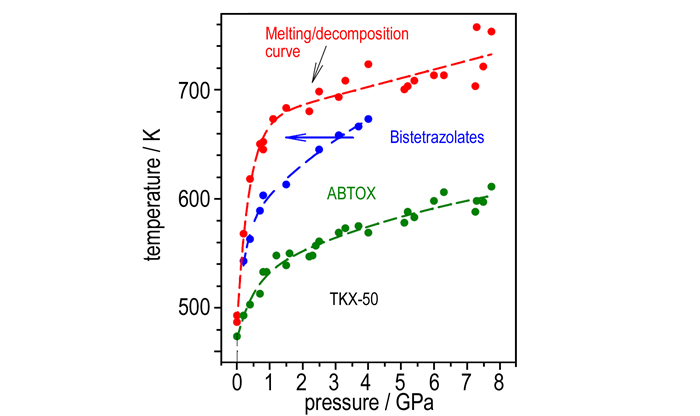2. 四川大学物理科学与技术学院, 四川 成都 610065;
3. 四川理工学院物理与电子工程学院, 四川 自贡 643000;
4. 西南交通大学材料科学与工程学院, 四川 成都 611756
2. College of Physical Science and Technology, Sichuan University, Chengdu 610065, China;
3. School of Physics and Electronic Engineering, Sichuan University of Science & Engineering, Zigong 643000, China;
4. School of Materials Science and Engineering, Southwest Jiaotong Univercity, Chengdu 611756, China
一般, 含能材料在爆炸分解之前都会经历一个相变过程, 这个过程无论是热加载还是冲击加载都会引起含能材料相结构的变化。众所周知, 含能材料在爆轰时, 其冲击波前沿附近的区域可能达到3500 ℃和35 GPa的高温高压, 在这样极端条件下还未分解的晶体结构和分子结构都可能产生变化, 研究这些晶体结构的相变演化机制有助于更深入理解炸药感度[1-10]。在含能材料存储方面, 研究不同晶体相在温度和压力作用下的稳定性机制, 有助于增加大家对炸药安全性的理解, 并有可能通过部分相变机制寻找提高稳定性的方法, 进而合成更低感度的含能材料。
近年来, 含能材料相变研究趋于成熟, 许多高温高压下的全新相结构被揭示出来, 一些原本在实验上无法明确的相变现象和机理可以被高精度计算机理论模拟方法较好的解释[10-19]。本文对常见含能材料的相变研究方法进行了总结, 介绍了常用的实验方法和理论方法及其在相变研究中的适用范围, 并归纳了不同分子构型类别的常见含能材料如黑索今(RDX), 奥克托今(HMX), 1, 1-二氨基-2.2-二硝基乙烯(FOX-7), 太安(PETN), 六硝基六氮杂异伍兹烷(CL-20)等在高温高压下的多种相结构, 综述了这些含能材料在不同相结构中的晶体构型信息、静态与冲击加载下的高温高压相变点和相分布以及部分相变机制, 并总结了这些研究中未达成一致的研究结果以及亟待发展的研究方向。
2 含能材料相变的研究方法 2.1 实验方法实验方面对含能材料高温下的相变研究主要采用的热分析方法有差示扫描量热法(DSC)[1]和热重分析法(TGA)[2], 可测定样品吸热或放热的速率和质量与温度或时间的关系, 由于横坐标都可以表示为温度, 这两种方法得到的曲线图可以很方便的放在一起比较。通常在某一温度下, 样品质量没有发生改变而热流量发生改变则预示着相变的发生。
高压方面的研究主要用金刚石对顶砧(DAC)[4]来实现对样品制造吉帕以上的高压环境, DAC主要结构由两个金刚石尖部对顶形成上下压砧, 而样品封装在压砧内, 由于压砧顶部面积极小, 故可形成超高压强。DAC经常与X射线衍射[5]或拉曼光谱[6]、红外光谱[7]联用, 而X射线衍射、拉曼、红外光谱则通常用于测量样品结构的改变, 以进行物相分析。通过对衍射谱或振动谱特征峰的对照分析可定性分析出样品是否相变, 亦可定量测得样品的晶格参数。图 1[8]为适合联用的DAC装置。由该装置实验环境下测定的不同压力下样品的拉曼光谱曲线。
冲击波作用下的相变研究需要使用Nd:YAG激光脉冲冲击细小飞片来对样品进行冲击加载[9]。激光脉冲经透镜聚焦后烧蚀镀在石英基底上的金属膜, 形成热膨胀等离子体, 推动Al箔飞片高速飞行, 并与试样进行平面撞击, 产生冲击波, 装置如图 2[9]。飞片撞击速度可以通过激光输出能量和焦斑大小进行调节。
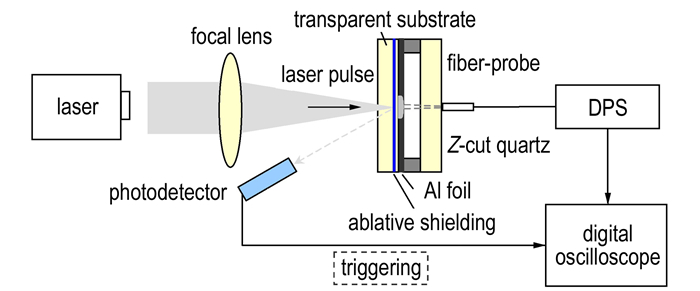
|
图 2 激光冲击实验装置及测试系统示意图[9] Fig.2 Schematic diagram of laser impact experimental device and test system[9] |
含能材料相变领域绝大部分理论研究使用第一性原理方法、分子动力学(MD)方法以及二者相结合的方法。对材料分子构型、晶体结构、能带结构以及振动特性等性质的计算多用第一性原理的方法完成, 最广泛使用的是密度泛函理论(DFT)方法[10], 将电子相互作用看做电子密度的函数, 考虑电子相关效应, 运算结果有足够高的精度, 计算效率高。但传统DFT方法不能准确考虑分子晶体间范德华力等色散相互作用, 所以低压下晶体结构的计算误差较大, 针对这一情况人们提出了新的校正理论DFT-D[11], 可更好的描述含能材料不同压强下的行为。
半经验的量子化学方法如电子自洽的紧束缚密度泛函(SCC-DFTB)方法[12]在相变研究中也有较多应用, 这类方法使用最简基组且只考虑价电子, 通过近似简化运算或用实验参数代替部分积分项, 以牺牲精度或泛用性为代价提高计算效率, 可计算粒子数量较多的体系。
在部分需要高精度的计算中(如相变过程中含能材料分子关键化学键的性质), 从头算方法(ab initio)也有使用, 如基于耦合簇方法的CCSD(T)方法[13], 通过在物理模型上对波函数或哈密顿量进行少量近似以达到薛定谔方程可解的程度, 使得计算结果十分精确, 但计算量较大, 模拟同样的体系需要花费更长的时间。
而热力学量、晶体参数和X射线衍射、红外光谱等可以使用分子动力学方法(MD)[14]来计算, 该方法利用力场描述粒子间相互作用以代替复杂的量子效应, 使得体系变为牛顿力学系统, 大大减小计算量, 可以模拟更大的体系, 如冲击加载下含能材料相变的体系。MD中的力场选用较为关键, 对于不同的体系应选用合适的力场, 适用于含能材料的力场主要有: COMPASS[15], SB(特别适合HMX)[16], ReaxFF[17]以及考虑长程作用的ReaxFF-lg力场[18]。但传统MD计算精度较低适合大体系, 对精度有一定要求的中等规模体系含能材料的计算需要将第一性原理与MD方法结合, 如CPMD方法[19], 利用赝势、平面波基组和DFT方法计算原子(分子)间作用力, 可以提高精度, 并且拥有比第一性原理方法更高的运算效率。
3 不同类型含能材料相变的研究进展 3.1 硝胺类硝胺类含能材料分子中含有N—NO2结构, 有代表性的品类有黑索今(RDX)和奥克托今(HMX), 这两种材料都是高能量含能材料, 作为炸药成分具有极优良的爆轰性能和相对较好的安全性。
RDX分子有AAE(图 3[21])与AAA(图 4[21])两种构型, 而AAI(图 5[23])则是介于两者之间的中间构型。RDX晶体主要有五种结构, 其中α-RDX为非极端条件下的稳定相[20], β-RDX是亚稳相RDX(图 4[21]), 存在于融化线附近[21-22], γ[23], δ[24-25], ε-RDX[26]存在于高压下。
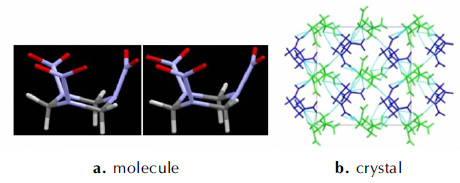
|
图 4 β-RDX的分子构型(AAA)和晶体结构[21] Fig.4 The molecular configuration (AAA) and crystal structure of β-RDX[21] |
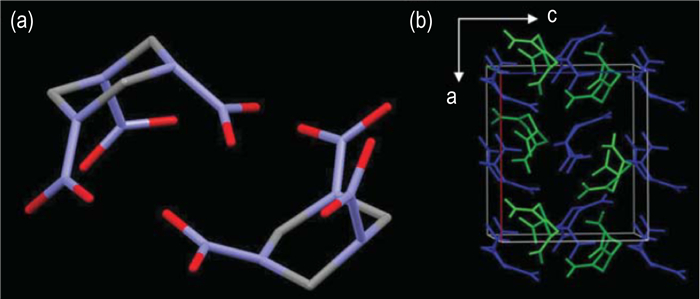
|
图 5 RDX分子在γ相晶体中的排列方式。蓝色为AAI构型分子, 绿色为AAA构型分子[23] Fig.5 The arrangement of RDX molecule in γ phase crystal. configurational molecule AAI shows in Blue and configurational molecule AAA shows in green[23] |
近年来由于实验条件不断成熟, 高压下RDX相的结构与转变逐渐成为研究热点。利用振动光谱对RDX在高压下相变的研究[24-25], 发现常温下4GPa左右, RDX发生α↔γ的可逆相变, 并首次在18 GPa附近观察到新相变(γ→δ)的发生。随后X光和中子衍射的高压相变的实验研究[23]得到γ相RDX分子在晶体中的排列方式, 见图 5。此后对RDX高压相变的理论模拟研究分别用分子动力学, DFT方法, Born-Oppenheimer分子动力学(BOMD)方法以及电子自洽的紧束缚密度泛函(SCC-DFTB)方法实现[27-30], 通过分析计算得到晶体参数、振动光谱、能带结构、热力学量等方面来佐证相变的发生。其中使用DFT方法的研究[28]发现在压强达到4 GPa时未发生相变[31], 而达到13 GPa时发生了结构相变, 与之前的实验结果不同。而使用BOMD与SCC-DFTB的研究[29-30]都在4 GPa左右发现了α→γ(图 6[29]), 由夹角突变分析出三个硝基与碳氮环的相对位置的改变, 即分子结构发生由AAE向AAI和AAA的转变, 以佐证相变的发生, 与实验数据[24-25]吻合, 说明基于半经验近似的密度泛函方法更适合处理RDX高压相变问题。在超高压方面, 通过DAC和共聚焦显微拉曼光谱等实验方法, 可研究最高达50 GPa高压下RDX晶体的结构演变[32], 发现静水压下α→γ转变发生于2.5 GPa, 结束于4.3 GPa, γ→δ转变发生在18.5 GPa。在非静水压下这两个相变分别发生在4.6 GPa和16.9 GPa。该研究在27.6 GPa下成功发现新相ζ, 该相可稳定存在于43 GPa以下并且相变可逆。
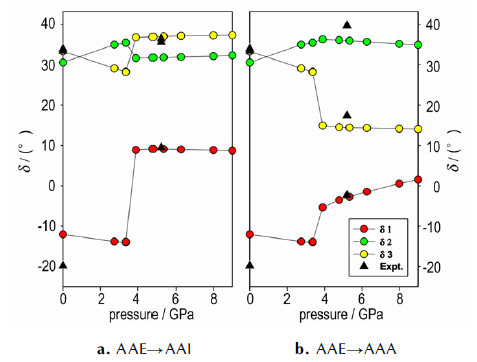
|
图 6 N—NO2键与C—N—C平面的夹角随压强的变化[29] Fig.6 Change in angle between N—NO2 bond and C—N—C plane with pressure[29] |
在α相向β相转变的方面, Infante-Castillo R等[33]利用拉曼光谱和DFT方法分别从实验和理论上研究了常压下对RDX加温至接近融化温度后冷却可以使其由α相向β相转变的过程。Torres P[34], Goldberg I G[35], Figueroa-Navedo A M[36], Ruiz-Caballero J L[37]等用旋涂仪将RDX溶液滴涂在不同基片的表面上(玻璃, 亲水性玻璃, 不锈钢, 金)使其结晶, 并通过红外、拉曼谱分析发现该过程发生了α→β相变, 但未能解释转变相关的机制。
而Baer B J[38], Miller P J[22], Ciezak J A[24]和Dreger Z A[39]等先后研究了RDX在不同温度和压强下的相分布, 测定了大量相变点, 并确定了相边界, 从而给出不同相的大致分布图, 本文综合上述研究结果, 定性的画出了目前可能的基于α-RDX相变的相分布图, 如图 7。
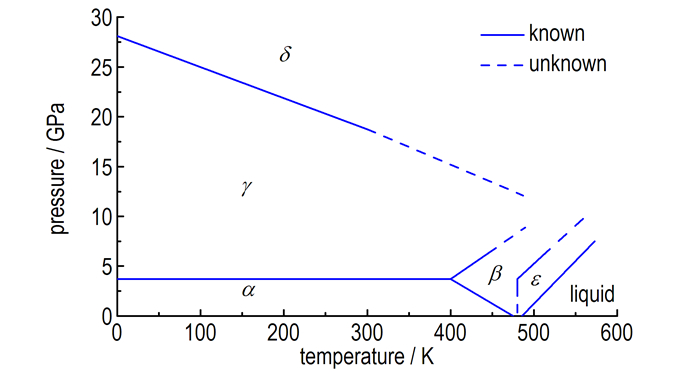
|
图 7 α-RDX相变的综合相分布图 Fig.7 Comprehensive phase distribution diagram of α-RDX phase transition |
由于爆炸初始阶段分子变形可能引发静态和冲击压缩条件下的化学反应, 故常温常压下的冲击加载亦可引起RDX相变。对RDX晶体进行冲击压缩的研究表明[40-41], 当压强达到4.5 GPa时RDX晶体开始发生α→γ转变, 并发现在压强达到5.5 GPa时相变有100 ns的延迟, 且该相变过程与冲击压缩的晶体方向没有关系。对RDX冲击相变的大体系分子动力学模拟[42]得到的相变压强在2.5 GPa左右。
HMX的爆速、热稳定性和化学稳定性都超过RDX, 因其较多的晶型和复杂的相变问题而受到广泛关注。它主要有α, β, γ和δ四种晶体结构和两种分子构型(图 8[52]), 其中α-, δ-和β-HMX是固体, γ-HMX是液体。常温常压下四种结构的稳定性为β>γ>α>δ[43]。α-HMX稳定存在于376~435 K[44], β-HMX在室温下最稳定[43], γ-HMX晶体中含有水分子且在常压下处于亚稳态[45], δ-HMX在433~553 K下稳定存在[46]。
在对β-HMX晶体结构的早期研究[47-49]中发现:当p<0.12 GPa时, 在375~377 K时β相转变为α相, 在423~443 K左右α相转变为δ相, 当p>0.12 GPa时, β相稳定存在直到分解。随后利用X散射方法对HMX四种晶型热膨胀行为的研究[50]中发现了β→δ, γ→δ, α→δ相变。
β-HMX作为最稳定的相, 是炸药制造中的常见产物, 其安全性需要进一步讨论, 故针对β-HMX的研究是必要的。Yoo等[8]采用金刚石压腔实验研究了β-HMX晶体在43 GPa下的状态方程, 并在压力达到12 GPa和27 GPa时分别观察到两次相变, 其中12 GPa下的相结构为新的ε相[51], 27 GPa下的相为另一个新相。
Lu L-Y等[53]和Cui H-L等[54]采用COMPASS力场的MD方法从理论模拟角度重新讨论了α-, β-和δ-HMX在高温高压下的晶体结构, 研究发现在298 K, 压力达到27 GPa时β-HMX的晶胞参数发生突变, 此时HMX由β相转变为δ相, 也即指出Yoo等[8]发现的27GPa新相实为δ相(之后Zhang L等[52]通过第一性原理方法模拟HMX高压下相变, 结果表明0 K温度下压力达12 GPa发生β→ε相变后, 直到50 GPa的过程中没有再出现其他相变)。上述研究[54]另外计算出β→α和α→δ相变发生在360 K和440 K, 与之前的实验数据[47-49]吻合, 说明COMPASS力场至少对于常压下温度变化导致的HMX相变的模拟较为精确。此外, 利用ReaxFF-lg力场结合MD方法对α-, β-和δ-HMX晶体的模拟研究, 得到了在一定温度范围内的晶体结构和分子结构随温度的变化关系[55], 并计算得到三种晶型的体膨胀系数从大到小依次为: δ-HMX>α-HMX>β-HMX, 在443 K时, β-HMX发生向δ-HMX的转变。
Ge N N等[56-57]使用MD与多尺度冲击技术(MSST)相结合的方法研究了冲击波作用下HMX分解的初始化学过程, 发现在不同方向的高速冲击(10, 11 km·s-1)下, HMX的N—NO2键的断裂都在高压下被抑制, C—H键先行解离。此结果与Cui等[58]的研究结论相符:压力作用下β-HMX晶体相变过程中, N—NO2和C—N键在压力越高的情况下越容易被压缩, 变得越稳定, 相反, C—H键变得越弱。
关于β→α相变方面, Long Y等[59]通过DFT方法计算了不同温度压强下α↔β可逆相变的吉布斯自由能曲线和雨贡纽曲线, 并得到静态和冲击下HMX的相分布(图 9[59]), 其中图 9a为静态下α-和β-HMX的相分布, 图 9b为冲击下的相分布。黑线为冲击α-HMX得到的相边界, 红线为冲击β-HMX得到的相边界。
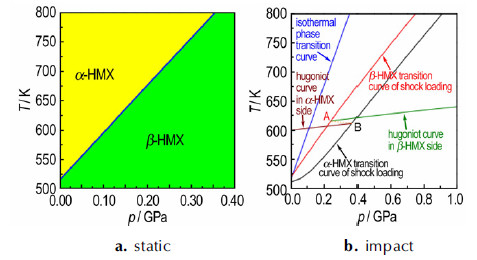
|
图 9 静态和冲击下HMX的相分布图[59] Fig.9 The phase distribution diagrams of HMX under the conditions of static and impact[59] |
由于δ-HMX相较于β-HMX有更高的感度[60], 基于炸药安全性的考虑, 针对β→δ相变有一些集中的讨论。Weese R K[61]和Burnham A K[62]等应用DSC分析了HMX的β→δ相变的动力学过程和晶体生长形核过程。Czerski H等[63]利用二次谐波发生(SHG)效应在HMX上的应用[64]研究了下落重物冲击下β-HMX向δ相的转变。Xue C等[65]用XRD分析了β与δ相的互相转变β↔δ, 测得的晶格参数和热膨胀系数表明β-HMX的b晶轴方向的分子之间静电力更弱。Dai X等[66]利用原位XRD结合量化分析研究了HMX混合炸药的相变, 发现HMX+TATB+olefin的PBX系统中HMX和TATB的组分下降时, HMX发生β→δ相变的温度上升。当HMX在PBX中的组分高于75%时, β→δ相变温度比纯HMX加热时发生相变的温度低, 当HMX在PBX中的组分低于50%时, 结果相反。
γ-HMX相变研究较少, Zhang L等[52]通过第一性原理方法模拟HMX高压下相变的研究中在2.10 GPa下发现了一个可能的γ→β相变, 其中水分子的迁移可能在动力学上促成了这个结果。
3.2 硝基类硝基类含能材料分子中含有C—NO2结构, 代表性的品类有:三硝基甲苯(TNT), 三氨基三硝基苯(TATB), 硝基甲烷(NM), 1, 1-二氨基-2, 2-二硝基乙烯(DADE, FOX-7)。其中TNT与TATB的性质非常稳定, 感度很低, 爆轰性能比RDX等稍弱, 常与其他稳定性较低的高爆炸药混合以降低感度。
TNT是传统炸药, 广泛用于起爆药, 它的晶体结构如图 10[68], 共有两个晶型, 分别属于单斜晶系和正交晶系。对于这两个固体相, 都有A、B两种构型(硝基扭转角不同)的分子以1:1的比例存在于晶体中[67-68]。
TNT的两个相都可以在常温常压下存在, 正交晶系相结构虽然是亚稳相, 但仍可以在常温常压下稳定数十月之久[68]。高压可以使TNT发生相变, 在2~4 GPa时发生可能的晶格的重排, 在20~22 GPa左右发生明显的“单斜→正交”相变[69-70]。
硝基甲烷(NM)是分子结构非常简单的含能材料, 常作为研究含能材料的原型, 在实验方面, 通过金刚石压腔技术(DAC)和拉曼散射光谱对NM的研究[71-73]发现NM在3~3.5, 7.5, 13.2 GPa发生结构相变, 并且在7.5 GPa时发生化学反应, 这种带化学反应的相变与硝基官能团有关。Citroni等[74]通过DAC和X射线衍射技术研究NM的结构随静水压的变化, 发现在高压下存在两次相变。理论方面, 采用DFT, DFT-D和经典分子动力学方法对高压下NM晶体结构与热力学性质的计算[75-78]表明在7~30 GPa NM会发生相变(图 11[77])。
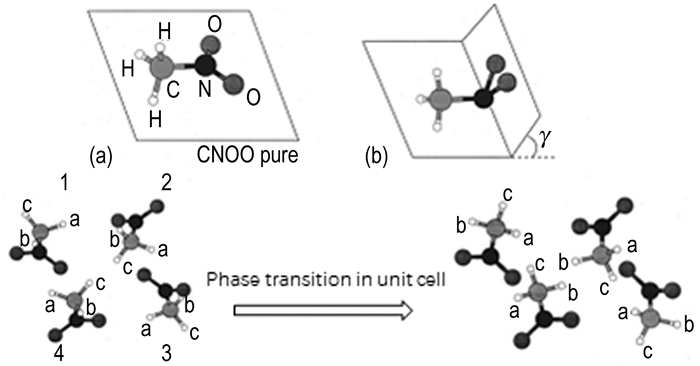
|
图 11 NM的两种分子构型(γ≈53°), 和高压下相变的晶体结构变化[77] Fig.11 The two molecular configurations of NM (γ≈53°) and the changes of the crystal structure of phase transition at high pressure[77] |
1, 1-二氨基-2, 2-二硝基乙烯(DADE, FOX-7)是非常优秀的高能炸药, 其爆轰性能与RDX相当, 感度与TATB相近。FOX-7共有6种晶体结构, 分别为α, β, γ, δ, α°和ε, 其中α-FOX-7在温度低于373 K左右的常压或低压下存在[79-81], 是最稳定的结构。β, γ和δ三个相在高温作用下才形成(图 12[87]), β-FOX-7稳定于373~418 K[79, 81], γ相稳定在418~423 K[79, 82], δ相稳定在488 K以上直至分解[83-84]。α°和ε相为高压作用下形成的相(图 13[88]), 分别在2 GPa和4.5 GPa下被观察到[85-86]。所有晶型的FOX-7都是层状结构[87-88]。
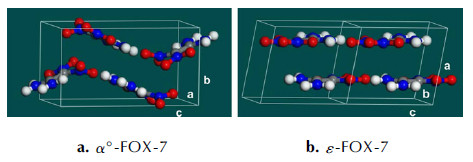
|
图 13 FOX-7在压力作用下形成的两种晶体结构[88] Fig.13 Two crystal structures formed under the action of pressure of FOX-7[88] |
Zakharov V V等[89]在高温条件下用X射线衍射法结合差示扫描量热法对FOX-7的研究证实了480 K以上δ相的稳定存在, 在将该构型的晶体降温至室温后发生了δ→γ相变, 得到的晶体(称为γ°)却与正常由β→γ相变产生的γ相晶体不同, γ°-FOX-7有更高的热稳定性, 在加温到480K后还能相变为δ相, 对其进行的红外光谱和X射线衍射得到的数据指出γ-FOX-7相比γ°-FOX-7在晶体结构上有更高的无序性。
越来越多的学者[85, 88, 90-91]在计算FOX-7的分子结构和能量时使用了DFT及更精细的DFT-D方法, 如Dreger Z A等[88, 91]的研究指出α°→ε的相变致使波浪层结构变为平面层结构, 且分子间氢键网络结构不变, 氢键键长变短, 结合C—C键和C—NO2键键长变短的结果可推测ε-FOX-7有更高的感度和稳定性。C—NO2键很可能是FOX-7的分解触发键, 它的稳定性与FOX-7感度关系密切。
Bishop M M等[84]系统研究了FOX-7在高温高压下的相变过程, 并测定了相变点, 最终给出了FOX-7较为完整的压强-温度相分布(图 14[84])。结果表明, FOX-7的两个三相点分别为:在0.5~0.9 GPa, 180~260 ℃下的(β+γ+δ)点, 和在1 GPa, 300 ℃下的(α+β+δ)点。
3.3 硝酸酯类硝酸酯类含能材料分子内含有O—NO2结构, 主要有太安(PETN)、硝化甘油(NG)、乙醇硝酸酯、乙二醇二硝酸酯, 丙三醇硝酸酯以及硝酸纤维素等。其中PETN能量高, 作为猛炸药爆轰性能好, 相关研究较多, 而其他硝酸酯类含能材料多用于发射药和推进剂。
季戊四醇四硝酸酯(PETN)作为高爆炸药威力强于RDX, 但相对感度也较高, 在实际应用时需要做钝化处理。PETN主要有四种晶体结构PETN-Ⅰ[92], PETN-Ⅱ[93], PETN-Ⅲ[95]和PETN-Ⅳ[95], 在常温常压下PETN处于Ⅰ相晶体结构属于四方晶系, Ⅰ相在接近融化的高温约414 K下转变为Ⅱ相, 其晶体结构属于斜方晶系(图 15[94])。Ⅲ和Ⅳ相为高压相。
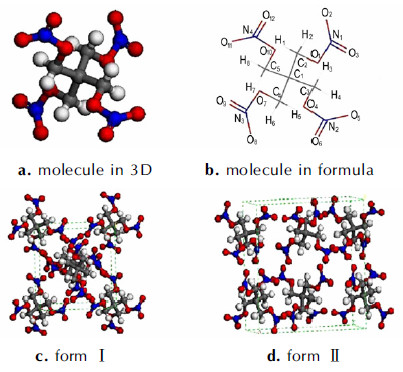
|
图 15 PETN的分子构型及Ⅰ相和Ⅱ相的晶体结构[94] Fig.15 The moleculare configuration and crystal structure of phases Ⅰ and Ⅱ of PETN[94] |
高压相变方面, Gruzdkov Y A等[95]在5 GPa左右发现了PETN分子结构由S4转为C2, 并在高温高压下可由C2转为C1, 即Ⅲ相和Ⅳ相。随后多个研究者对这一现象展开了拉曼、红外光谱和X射线衍射的研究[96-101], 在6~14.8 GPa内确定了PETN-Ⅰ向PETN-Ⅲ的转变, 而PETN-Ⅲ的晶体结构和分子构型都未能确定, Ciezak J A等[99]认为PETN-Ⅲ晶体结构与PETN-Ⅰ相同为P421c, 但Ⅲ相分子构型为D2与Ⅰ相分子构型S4不同, Tschauner O等[100]利用DFT方法的理论计算结果则正好相反, Ⅲ相晶体结构为P21212与Ⅰ相不同, 而分子构型同为S4, Dreger Z A[101]与Gruzdkov Y A等[95]则认为Ⅲ相分子构型为C2。研究冲击加载下的性质[95, 102-103]发现, 沿1 1 0面冲击作用下PETN-Ⅰ会在6.5 GPa以上发生Ⅰ→Ⅲ相变。Dreger Z A等[101]用拉曼光谱, 对高温高压下PETN的相变做了系统研究, 发现Ⅰ→Ⅲ相变压力在常温8.5 GPa左右, 并在9.2 GPa, 409 K下确定了Ⅳ相的产生, 并通过测定相变点画出了p-T相分布图, 如图 16[101]。
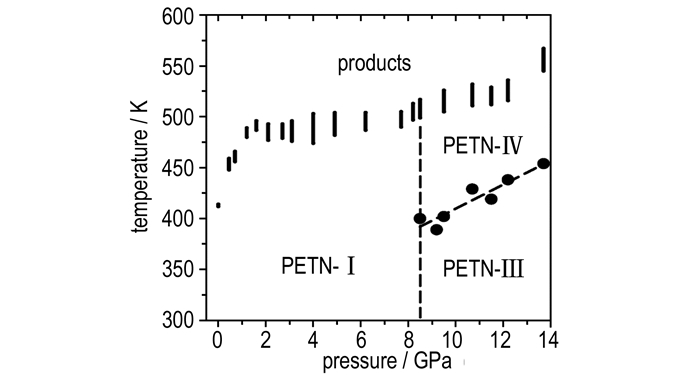
|
图 16 PETN的相分布图(PETN-Ⅱ产生在分解线附近, 没有在图中标注出来)[101] Fig.16 The phase distribution diagram of PETN (PETN-Ⅱ is generated near the decomposition line, not marked in the figure)[101] |
唑类含能材料一般由杂氮五元环与含能基团组成, 呋咱类含能材料一般由氮氧五元杂环与含能基团组成, 对这些含能材料的研究主要集中在合成与分解方面, 对其相变的相关研究较少, 大多不具系统性。
目前, 作为新型唑类含能离子盐材料的1, 1′-二羟基-5, 5′-联四唑二羟胺盐(TKX-50)成为研究热点, 其爆轰性能优异, 热感度与撞击感度低, 有取代传统CNOH炸药的趋势, 与其相关的相变研究意义较大。
采用DSC研究TKX-50的高温反应[104-105]发现其可以在210~250 ℃保持热稳定不发生相变, 而最近LuZ等[3]采用热重分析法、差示扫描量热法结合拉曼光谱研究了TKX-50的温度反应, 发现在180 ℃左右发生了相变, 并利用从头算方法计算了拉曼光谱和晶体结构以佐证实验数据, 见图 17[3]。
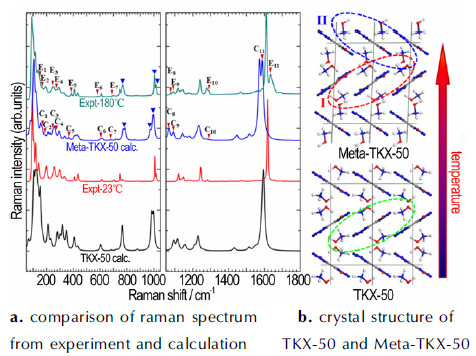
|
图 17 温度影响TKX-50相变的拉曼光谱与结构图[3] Fig.17 Raman spectra and structure diagrams of temperature induced TKX-50 phase transition[3] |
Dreger Z A等[106-108]研究了0~50 GPa, 293~760 K下TKX-50的结构变化, 发现在高压下恒压加温可以使TKX-50在分解之前经历两次带有化学反应的相变, 并给出了p-T相分布图, 见图 18[107]。
3.5 笼型笼型含能材料主要代表有四硝基金刚烷, 八硝基立方烷和六硝基六氮杂异伍兹烷(HNIW, CL-20)。其中四硝基金刚烷, 八硝基立方烷的分子对称性极高, 难以发生相变。而, CL-20是目前实际应用的爆轰性能最强的炸药, 相较HMX有更高的生成焓和更好的氧平衡[109], 且拥有较多晶型, 相变复杂。
CL-20主要有5种晶型(图 19[113, 118]): α[110-111], β[111], γ[112], ε[113]和ζ[114], 其中α-CL-20的晶体单元中包含H2O分子[110], 属于水合物, ε-CL-20有最好的热稳定性和最高的能量密度[115], 前4种晶型都可以在常温常压下存在[116-117]其热稳定性为ε>γ>α>β[111], ζ-CL-20是高压下的晶型。
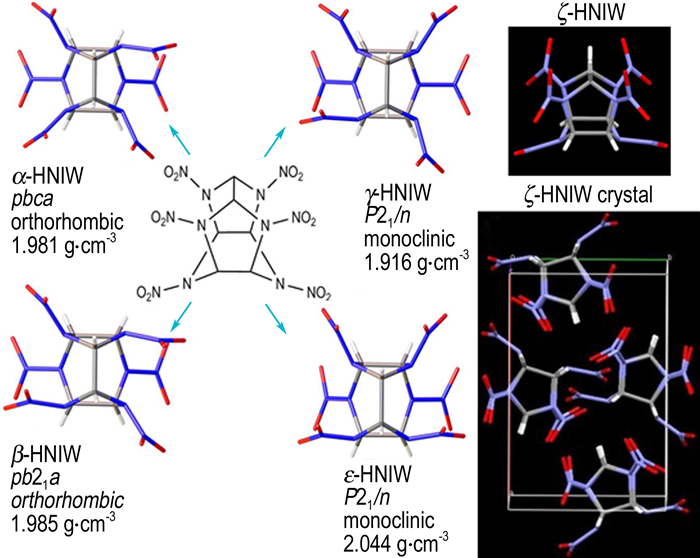
|
图 19 CL-20的各种晶型及其分子构型[113, 118] Fig.19 The various crystal forms and molecular configurations of CL-20[113, 118] |
Gump J C等[119-120]通过X射线衍射技术分析ε-CL-20在高温高压下相变, 发现常温下静水压达6.3 GPa和非静水压达7.1 GPa以及常压下温度达75 ℃都无相变发生, 常压下125 ℃开始出现明显的ε→γ的转变, 150 ℃以上发生热分解。Ciezak J A等[114]利用红外和拉曼光谱对27 GPa下ε-CL-20相变研究发现CL-20在4.1~6.4 GPa内由ε相转为γ相, 在18.7 GPa附近看到γ→ζ相变的迹象, 而随后Millar D I A等[113]的研究发现将常温常压下的γ-CL-20加压至3.3 GPa就发生了γ→ζ相变。
利用傅里叶变换红外(FT-IR)光谱分析常压下147~159 ℃的ε→γ, α→γ和β→γ相变的研究[121]得到了温度和相变率的关系, 并计算了活化能随相变率的变化, 发现在初始5%相变率对应的活化能几乎相等的情况下, 上述三种相变过程分别在达到了40%, 80%和60%相变率时对应的活化能也随之达到极值, 并且三个极值相差无几。但该研究未能解释其原因, 只能说明CL-20的相变机制极为复杂。随后Ghosh M等[122]研究了常温常压下β→ε以及β→α的相变过程, 其中后者在相变过程中需要有水分子的参与, 且后者在宏观上的相变速度远快于前者。
理论方面, Xu X J等[123]采用DFT方法计算了α, β, γ和ε 4种CL-20晶型的能带、密利根布居、态密度等, 并结合分析带隙特点指出N—NO2很有可能是热分解的触发键, 4种晶型的感度排序为: ε<β<γ<α, 在压力作用下ε-CL-20的压缩性是各向异性的, 且压力越大带隙越小, 感度越高, 在压力达到400 GPa时有产生金属性的趋势(图 20[123]), 态密度曲线在高压下趋于平滑表明电子可出现在任何能量区域, 是金属化的表现。
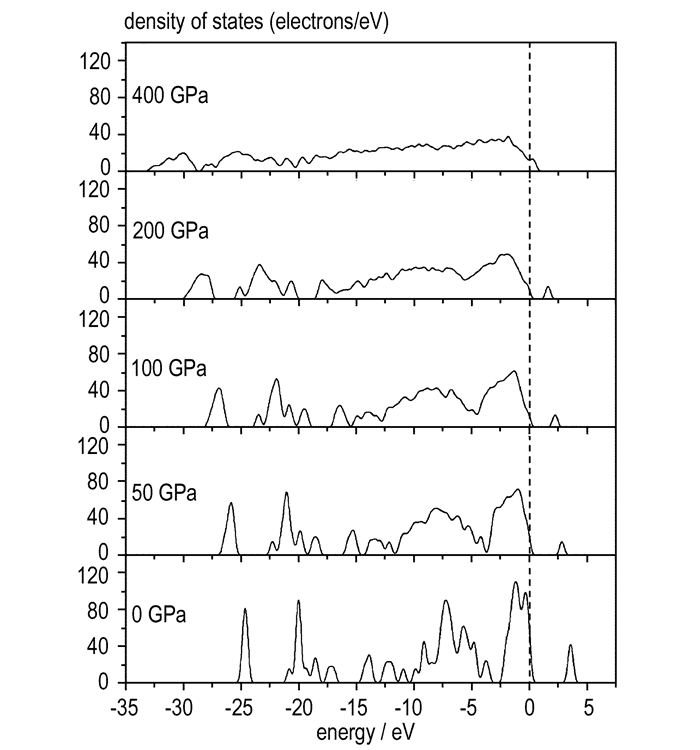
|
图 20 ε-CL-20在不同压强下态密度与能量的关系[123] Fig.20 Relationship between state density and energy of ε-CL-20 under different pressure[123] |
ε-CL-20与不同添加剂或粘合剂混合后可能降低感度并影响其ε→γ温度相变, 多项研究发现[118, 124-125], 在与拥有较高偶极矩或含有CL-20溶解基团的材料混合后ε-CL-20更容易极化, 致使ε→γ相变发生, 而ε-CL-20分别与TATB、聚乙烯(PE)、高氯酸铵(AP)和铝(Al)混合后, 其相变特性并无改变。分别与聚乙烯吡咯烷酮(PVP)和聚醚酰亚胺(PEI)混合后相变被抑止直到分解, 其中Zhang P等[124]的研究发现纯ε-CL-20在150 ℃发生完全的向γ相的转变, 并且冷却后不能发生逆相变, 而Liu Y等[118]在对CL-20温度相变的研究中发现这一相变过程开始发生于150 ℃直到180 ℃时相变完成, 这种不同很有可能是由所研究样品的差异性导致的。进一步的研究给出了解释[118]:样品的相变初始温度随样品纯度提高和粒径减小而升高。
最近, Zhang J-Y等[126]结合上述结果选用初始相变温度为135 ℃并能在180 ℃产生完全相变的ε-CL-20样品, 与不同添加剂混合制成混合炸药, 并对这些混合炸药样品进行30~180 ℃的等速率缓慢加温, 得到不同样品的初始相变温度, 达到50%相变率的温度和180 ℃下样品的相变率, 对CL-20炸药实验和制造中的降低热感度问题有指导意义。
CL-20相变种类繁多机制复杂, 现有的研究离散性较强, 在解释相变上难以得到一些有力的结论, 需要更多的研究来细化这些过程。
4 总结本文综述了含能材料相变的研究近况, 多种常见含能材料如RDX, HMX, FOX-7, PETN, CL-20等研究较多且更深入广泛, 上述含能材料(包括部分混合炸药)在高温高压下的多种相结构被揭示, 通过精确的理论与实验研究确定了晶体结构信息与相变点和相应的相分布图以及部分相变机理。然而目前的研究还不够完善, 其中没有研究清楚甚至尚未涉及但亟待解决的问题综合有以下几点:
(1) 多种拥有复杂相变机制的含能材料(CL-20, TKX-50等)的高温高压行为尚不清楚。
(2) 部分含能材料在高压下仍存在未知相变的可能, 如RDX等。
(3) 一些含能材料如PETN的部分相的晶体结构尚不清楚, 需要理论计算的预测和验证。
(4) 相变的深层次理论机理揭示不足, 大量报道只发现了相变过程而未能深究其机制原理, 甚至没有确定的相变点, 需要更多高精度理论计算的支持。
(5) 混合炸药相变的微观机理研究较少, 特别是在微观下不同炸药分子混合后温度压力行为的第一性原理理论研究亟待开展。
| [1] |
Bershteǐn V A, Egorov V M.
Differential scanning calorimetry of polymers: physics, chemistry, analysis, technology[M]. UK: Ellis Horwood, 1997.
|
| [2] |
Broido A. A simple, sensitive graphical method of treating thermogravimetric analysis data[J].
Journal of Polymer Science Part B: Polymer Physics, 1969, 7(10): 1761-1773. DOI:10.1002/pol.1969.160071012 |
| [3] |
Lu Z, Xue X, Meng L, et al. Heat-induced solid-solid phase transformation of TKX-50[J].
The Journal of Physical Chemistry C, 2017, 121(15): 8262-8271. DOI:10.1021/acs.jpcc.7b00086 |
| [4] |
Jayaraman A. Diamond anvil cell and high-pressure physical investigations[J].
Review of Modern Physics, 1983, 55(55): 65-108. |
| [5] |
Alberi G, Baldracchini F. X-ray diffraction in crystals, imperfect crystals, and amorphous bodies[J].
Physics Today, 1964, 17(4): 70-72. |
| [6] |
K K, H K, I I, et al. Ultrasensitive chemical analysis by Raman spectroscopy[J].
ChemInform, 1999, 30(50): 2957-2976. |
| [7] |
Günzler H, Gremlich H U.
IR spectroscopy : an introduction[M]. Wiley-VCH: 2002.
|
| [8] |
Yoo C S, Cynn H. Equation of state, phase transition, decomposition of β-HMX (octahydro-1, 3, 5, 7-tetranitro-1, 3, 5, 7-tetrazocine) at high pressures[J].
The Journal of Chemical Physics, 1999, 111(22): 10229-10235. DOI:10.1063/1.480341 |
| [9] |
李俊, 李加波, 周显明, 等. 纳秒激光冲击加载的全过程诊断[J].
高压物理学报, 2011, 26(4): 369-374. LI Jun, LI Jia-bo, ZHOU Xian-ming, et al. An integrated velocity profile measurement from nanosecond pulse laser-driven mini-flyer to shocked sample[J]. Chinese Journal of High Pressure Physics, 2011, 26(4): 369-374. |
| [10] |
Cohen A J, Mori-Sanchez P, Yang W. Insights into current limitations of density functional theory[J].
Science, 2008, 321(5890): 792-794. DOI:10.1126/science.1158722 |
| [11] |
Grimme S. Semiempirical GGA-type density functional constructed with a long-range dispersion correction[J].
Journal of computational chemistry, 2006, 27(15): 1787-1799. DOI:10.1002/(ISSN)1096-987X |
| [12] |
Cui Q, Elstner M, Kaxiras E, et al. A QM/MM implementation of the self-consistent charge density functional tight binding (SCC-DFTB) method[J].
The Journal of Physical Chemistry B, 2001, 105(2): 569-585. DOI:10.1021/jp0029109 |
| [13] |
Urban M, Noga J, Cole S J, et al. Towards a full CCSDT model for electron correlation[J].
Journal of Chemical Physics, 1985, 83(8): 4041-4046. DOI:10.1063/1.449067 |
| [14] |
Rapaport D C.
The art of molecular dynamics simulation[M]. Cambridge University Press, 2004.
|
| [15] |
Sun H. COMPASS: an ab initio force-field optimized for condensed-phase applications overview with details on alkane and benzene compounds[J].
The Journal of Physical Chemistry B, 1998, 102(38): 7338-7364. DOI:10.1021/jp980939v |
| [16] |
Smith G D, Bharadwaj R K. Quantum chemistry based force field for simulations of HMX[J].
The Journal of Physical Chemistry B, 1999, 103(18): 3570-3575. DOI:10.1021/jp984599p |
| [17] |
Van Duin A C, Dasgupta S, Lorant F, et al. ReaxFF: a reactive force field for hydrocarbons[J].
The Journal of Physical Chemistry A, 2001, 105(41): 9396-9409. DOI:10.1021/jp004368u |
| [18] |
Liu L, Liu Y, Zybin S V, et al. ReaxFF-lg: correction of the ReaxFF reactive force field for London dispersion, with applications to the equations of state for energetic materials[J].
The journal of physical chemistry A, 2011, 115(40): 11016-11022. DOI:10.1021/jp201599t |
| [19] |
Andreoni W, Curioni A. New advances in chemistry and materials science with CPMD and parallel computing[J].
Parallel Computing, 2000, 26(7-8): 819-842. DOI:10.1016/S0167-8191(00)00014-4 |
| [20] |
Hakey P, Ouellette W, Zubieta J, et al. Redetermination of cyclo-trimethyl-ene-trinitramine[J].
Acta crystallographica Section E, Structure reports online DOI:10.1107/S1600536808019727 |
| [21] |
Millar D I, Oswald I D, Francis D J, et al. The crystal structure of beta-RDX-an elusive form of an explosive revealed[J].
Chemical communications, 2009, 5: 562-564. |
| [22] |
Miller P J, Block S, Piermarini G J. Effects of pressure on the thermal decomposition kinetics, chemical reactivity and phase behavior of RDX[J].
Combustion and Flame, 1991, 83(1-2): 174-184. DOI:10.1016/0010-2180(91)90211-S |
| [23] |
Davidson A J, Oswald I D H, Francis D J, et al. Explosives under pressure—the crystal structure of γ-RDX as determined by high-pressure X-ray and neutron diffraction[J].
Cryst Eng Comm, 2008, 10(2): 162-165. DOI:10.1039/B715677B |
| [24] |
Ciezak J A, Jenkins T A. The Low-temperature high-pressure phase diagram of energetic materials: Ⅰ. hexahydro-1, 3, 5-trinitro-s-triazine[J].
Propellants, Explosives, Pyrotechnics, 2008, 33(5): 390-395. DOI:10.1002/prep.v33:5 |
| [25] |
Ciezak J A, Jenkins T A, Liu Z, et al. High-pressure vibrational spectroscopy of energetic materials: Hexahydro-1, 3, 5-trinitro-1, 3, 5-triazine[J].
The Journal of Physical Chemistry A, 2007, 111(1): 59-63. DOI:10.1021/jp063150q |
| [26] |
Millar D I, Oswald I D, Barry C, et al. Pressure-cooking of explosives-the crystal structure of epsilon-RDX as determined by X-ray and neutron diffraction[J].
Chemical communications, 2010, 46(31): 5662-5664. DOI:10.1039/c0cc00368a |
| [27] |
Pereverzev A, Sewell T D, Thompson D L. Molecular dynamics study of the pressure-dependent terahertz infrared absorption spectrum of alpha-and gamma-RDX[J].
J Chem Phys, 2013, 139(4): 044108 DOI:10.1063/1.4813795 |
| [28] |
Wu Q, Zhu W, Xiao H. Periodic DFT study of structural, electronic, absorption, and thermodynamic properties of crystalline α-RDX under hydrostatic compression[J].
Structural Chemistry, 2013, 25(2): 451-461. |
| [29] |
Sorescu D C, Rice B M. RDX compression, α→γ phase transition, and shock hugoniot calculations from density-functional-theory-based molecular dynamics simulations[J].
The Journal of Physical Chemistry C, 2016, 120(35): 19547-19557. DOI:10.1021/acs.jpcc.6b06415 |
| [30] |
Yuan J, Ji G, Chen X, et al. Phase transition, thermodynamics properties and IR spectrum of α-and γ-RDX: First principles and MD studies[J].
Chemical Physics Letters, 2016, 644: 250-254. DOI:10.1016/j.cplett.2015.11.062 |
| [31] |
Miao M S, Dreger Z A, Winey J M, et al. Density functional theory calculations of pressure effects on the vibrational structure of alpha-RDX[J].
The Journal of Physical Chemistry A, 2008, 112(47): 12228-12234. DOI:10.1021/jp807285u |
| [32] |
Gao C, Zhang C, Sui Z, et al. Phase transition of RDX under high pressure upto 50 GPa[C]//26th ICDERS. Boston, MA, USA. 2017.
|
| [33] |
Infante Castillo R, Pacheco Londoño L C, Hernández Rivera S P. Monitoring the α→β solid-solid phase transition of RDX with Raman spectroscopy: A theoretical and experimental study[J].
Journal of Molecular Structure, 2010, 970(1-3): 51-58. DOI:10.1016/j.molstruc.2010.02.021 |
| [34] |
Torres P, Mercado L, Cotte I, et al. Vibrational spectroscopy study of β and α RDX deposits[J].
J Phys Chem. B, 2004, 108(26): 8799-8805. DOI:10.1021/jp0373550 |
| [35] |
Goldberg I G, Swift J A. New Insights into the metastable β form of RDX[J].
Crystal Growth & Design, 2012, 12(2): 1040-1045. |
| [36] |
Figueroa-Navedo A M, Ruiz-Caballero J L, Pacheco-Londoño L C, et al. Characterization of α-and β-RDX polymorphs in crystalline deposits on stainless steel substrates[J].
Crystal Growth & Design, 2016, 16(7): 3631-3638. |
| [37] |
Ruiz-Caballero J L, Aparicio-Bolano J A, Figueroa-Navedo A M, et al. Optical properties of beta-RDX thin films deposited on gold and stainless steel substrates calculated from Reflection-absorption Infrared spectra[J].
Applied Spectroscopy, 2017, 71(8): 1990-2000. DOI:10.1177/0003702817710248 |
| [38] |
Baer B J, Oxley J, Nicol M. The phase diagram of rdx (hexahydro-1, 3, 5-trinitro-s-triazine) under hydrostatic pressure[J].
High Pressure Research, 1990, 2(2): 99-108. DOI:10.1080/08957959008201441 |
| [39] |
Dreger Z A, Gupta Y M. Phase diagram of hexahydro-1, 3, 5-trinitro-1, 3, 5-triazine crystals at high pressures and temperatures[J].
The Journal of Physical Chemistry A, 2010, 114(31): 8099-8105. DOI:10.1021/jp105226s |
| [40] |
Patterson J E, Dreger Z A, Gupta Y M. Shock wave-induced phase transition in RDX single crystals[J].
The Journal of Physical Chemistry B, 2007, 111(37): 10897-10904. DOI:10.1021/jp079502q |
| [41] |
Dang N C, Dreger Z A, Gupta Y M, et al. Time-resolved spectroscopic measurements of shock-wave induced decomposition in cyclotrimethylene trinitramine (RDX) crystals: anisotropic response[J].
Journal of Physical Chemistry A, 2010, 114(43): 11560-11566. DOI:10.1021/jp106892c |
| [42] |
Bedrov D, Hooper J B, Smith G D, et al. Shock-induced transformations in crystalline RDX: A uniaxial constant-stress Hugoniostat molecular dynamics simulation study[J].
The Journal of Chemical Physics, 2009, 131(3): 034712 DOI:10.1063/1.3177350 |
| [43] |
Goetz F, Brill T B, Ferraro J R. Pressure dependence of the Raman and infrared spectra of.alpha.-, .beta.-, .gamma.-, and.delta.-octahydro-1, 3, 5, 7-tetranitro-1, 3, 5, 7-tetrazocine[J].
Journal of Physical Chemistry, 1978, 82(17): 1912-1917. DOI:10.1021/j100506a011 |
| [44] |
Cady H H, Larson A C, Cromer D T. The crystal structure of α-HMX and a refinement of the structure of β-HMX[J].
Acta Crystallographica, 1963, 16(7): 617-623. DOI:10.1107/S0365110X63001651 |
| [45] |
Main P, Cobbledick R E, Small R W H. Structure of the fourth form of 1, 3, 5, 7-tetranitro-1, 3, 5, 7-tetraazacyclooctane (γ-HMX), 2C4H8N8O8.0.5H2O[J].
Acta Crystallographica, 1985, 41(9): 1351-1354. |
| [46] |
Cobbledick R E, Small R W H. The crystal structure of the δ-form of 1, 3, 5, 7-tetranitro-1, 3, 5, 7-tetraazacyclooctane (δ-HMX)[J].
Acta Crystallographica Section B: Structural Crystallography and Crystal Chemistry, 1974, 30(8): 1918-1922. DOI:10.1107/S056774087400611X |
| [47] |
Cady H H, Smith L C.
Studies on the polymorphs of HMX[M]. Los Alamos Scientific Laboratory of the University of California: 1962.
|
| [48] |
Saw C K. Kinetics of HMX and phase transitions: effects of grain size at elevated temperature [R]. No. UCRL-JC-145228, Lawrence Livermore National Lab, CA (US), 2002.
|
| [49] |
Landers A G, Brill T B. Pressure-temperature dependence of the.beta.-.delta. polymorph interconversion in octahydro-1, 3, 5, 7-tetranitro-1, 3, 5, 7-tetrazocine[J].
Journal of Physical Chemistry, 1980, 84(26): 3573-3577. DOI:10.1021/j100463a015 |
| [50] |
Herrmann M, Engel W, Eisenreich N. Thermal analysis of the phases of HMX using X-ray diffraction[J].
Zeitschrift Für Kristallographie, 1993, 204(Part-1): 121-128. |
| [51] |
Korsunskii B L, Aldoshin S M, Vozchikova S A, et al. A new crystalline HMX polymorph: εHMX[J].
Russian Journal of Physical Chemistry B, 2011, 4(6): 934-941. |
| [52] |
Zhang L, Jiang S L, Yu Y, et al. Phase transition in octahydro-1, 3, 5, 7-tetranitro-1, 3, 5, 7-tetrazocine (HMX) under static compression: An application of the first-principles method specialized for CHNO solid explosives[J].
The Journal of Physical Chemistry B, 2016, 120(44): 11510-11522. DOI:10.1021/acs.jpcb.6b08092 |
| [53] |
Lu L-Y, Wei D-Q, Chen X-R, et al. The pressure-induced phase transition of the solid β-HMX[J].
Molecular Physics, 2009, 107(22): 2373-2385. DOI:10.1080/00268970903313642 |
| [54] |
Cui H-L, Ji G-F, Chen X-R, et al. Phase transitions and mechanical properties of octahydro-1, 3, 5, 7-tetranitro-1, 3, 5, 7-tetrazocine in different crystal phases by molecular dynamics simulation[J].
Journal of Chemical & Engineering Data, 2010, 55(9): 3121-3129. |
| [55] |
周婷婷, 黄风雷. HMX不同晶型热膨胀特性及相变的ReaxFF分子动力学模拟[J].
物理学报, 2012, 61(24): 246501 ZHOU Ting-ting, HUANG Feng-lei. Thermal expansion behaviors and phase transitions of HMX polymorphs via ReaxFF molecular dynamics simulations[J]. Acta Phys Sin, 2012, 61(24): 246501 DOI:10.7498/aps.61.246501 |
| [56] |
Ge N N, Wei Y K, Ji G F, et al. Initial decomposition of the condensed-phase beta-HMX under shock waves: molecular dynamics simulations[J].
The Journal of Physical Chemistry B, 2012, 116(46): 13696-13704. DOI:10.1021/jp309120t |
| [57] |
Ge N N, Wei Y K, Song Z F, et al. Anisotropic responses and initial decomposition of condensed-phase beta-HMX under shock loadings via molecular dynamics simulations in conjunction with multiscale shock technique[J].
The Journal of Physical Chemistry B, 2014, 118(29): 8691-8699. DOI:10.1021/jp502432g |
| [58] |
Cui H L, Ji G F, Chen X R, et al. First-principles study of high-pressure behavior of solid β-HMX[J].
The Journal of Physical Chemistry A, 2009, 114(2): 1082-1092. |
| [59] |
Long Y, Chen J. Theoretical study of phonon density of states, thermodynamic properties and phase transitions for HMX[J].
Philosophical Magazine, 2014, 94(23): 2656-2677. DOI:10.1080/14786435.2014.927598 |
| [60] |
Asay B W, Henson B F, Smilowitz L B, et al. On the difference in impact sensitivity of beta and delta HMX[J].
Journal of Energetic Materials, 2003, 21(4): 223-235. DOI:10.1080/713770434 |
| [61] |
Weese R K, Maienschein J L, Perrino C T. Kinetics of the β→δ solid·solid phase transition of HMX, octahydro-1, 3, 5, 7-tetranitro-1, 3, 5, 7-tetrazocine[J].
Thermochimica Acta, 2003, 401(1): 1-7. DOI:10.1016/S0040-6031(03)00050-9 |
| [62] |
Burnham A K, Weese R K, Weeks B L. A distributed activation energy model of thermodynamically inhibited nucleation and growth reactions and its application to the β-δ phase transition of HMX[J].
The Journal of Physical Chemistry B, 2004, 108(50): 19432-19441. DOI:10.1021/jp0483167 |
| [63] |
Czerski H, Greenaway M W, Proud W G, et al. β-δ Phase transition during dropweight impact on cyclotetramethylene-tetranitroamine[J].
Journal of Applied Physics, 2004, 96(8): 4131-4134. DOI:10.1063/1.1790067 |
| [64] |
Henson B F, Asay B W, Sander R K, et al. Dynamic measurement of the HMX β-δ phase transition by second harmonic generation[J].
Physical Review Letters, 1999, 82(6): 1213-1216. DOI:10.1103/PhysRevLett.82.1213 |
| [65] |
Xue C, Sun J, Kang B, et al. The β-δ-phase transition and thermal expansion of octahydro-1, 3, 5, 7-tetranitro-1, 3, 5, 7-tetrazocine[J].
Propellants, Explosives, Pyrotechnics, 2010, 35(4): 333-338. DOI:10.1002/prep.200900036 |
| [66] |
Dai X, Xu J, Wen Y, et al. Delay mechanism of β→δ phase transition of cyclotetramethylene tetranitramine in polymer bonded explosive formulations by heat conduction obstacle[J].
Propellants, Explosives, Pyrotechnics, 2016, 41(4): 637-640. DOI:10.1002/prep.v41.4 |
| [67] |
Vrcelj R M, Gallagher H G, Sherwood J N. Polymorphism in 2, 4, 6-trinitrotoluene crystallized from solution[J].
Journal of the American Chemical Society, 2001, 123(10): 2291-2295. DOI:10.1021/ja0031422 |
| [68] |
Vrcelj R M, Sherwood J N, Kennedy A R, et al. Polymorphism in 2-4-6 trinitrotoluene[J].
Crystal Growth & Design, 2003, 3(6): 1027-1032. |
| [69] |
Stevens L L, Velisavljevic N, Hooks D E, et al. The high-pressure phase behavior and compressibility of 2, 4, 6-trinitrotoluene[J].
Applied Physics Letters, 2008, 93(8): 081912 DOI:10.1063/1.2973162 |
| [70] |
Bowden P R, Chellappa R S, Dattelbaum D M, et al. The high-pressure phase stability of 2, 4, 6-trinitrotoluene (TNT)[J].
Journal of Physics: Conference Series, 2014, 500(5): 052006 DOI:10.1088/1742-6596/500/5/052006 |
| [71] |
Cromer D T, Ryan R R, Schiferl D. The structure of nitromethane at pressures of 0.3 to 6.0 GPa[J].
Journal of Physical Chemistry, 1985, 89(11): 2315-2318. DOI:10.1021/j100257a034 |
| [72] |
Courtecuisse S, Cansell F, Fabre D, et al. Phase transitions and chemical transformations of nitromethane up to 350 ℃ and 35 GPa[J].
Journal of Chemical Physics, 1995, 102(2): 968-974. DOI:10.1063/1.469165 |
| [73] |
Courtecuisse S, Cansell F, Fabre D, et al. Comparative Raman spectroscopy of nitromethane-h3, nitromethane-d3, and nitroethane up to 20 GPa[J].
Journal of Chemical Physics, 1998, 108(17): 7350-7355. DOI:10.1063/1.476154 |
| [74] |
Citroni M, Datchi F, Bini R, et al. Crystal structure of nitromethane up to the reaction threshold pressure[J].
Journal of Physical Chemistry B, 2008, 112(4): 1095-1103. DOI:10.1021/jp0771318 |
| [75] |
Sorescu D C, Rice B M, Thompson D L. Theoretical studies of solid nitromethane[J].
Journal of Physical Chemistry B, 2000, 104(35): 8406-8419. DOI:10.1021/jp000942q |
| [76] |
Reed E J, Joannopoulos J D, Fried L E. Electronic excitations in shocked nitromethane[J].
Physical Review B, 2000, 62(24): 16500-16509. DOI:10.1103/PhysRevB.62.16500 |
| [77] |
Margetis D, Kaxiras E, Elstner M, et al. Electronic structure of solid nitromethane: Effects of high pressure and molecular vacancies[J].
The Journal of Chemical Physics, 2002, 117(2): 788-799. DOI:10.1063/1.1466830 |
| [78] |
张力, 陈朗. 固相硝基甲烷相变的第一性原理计算[J].
物理学报, 2014, 63(9): 349-358. ZHANG Li, CHEN Lang. First principles calculations of solid phase transition of nitromethane[J]. Acta Phys Sin, 2014, 63(9): 349-358. |
| [79] |
Zakharov V V, Chukanov N V, Chervonnyi A D, et al. Kinetics of reversible polymorphic transition in energetic materials. Phase transitions α → β and β → α in 1, 1-diamino-2, 2-dinitroethylene[J].
Russian Journal of Physical Chemistry B, 2015, 8(6): 822-828. |
| [80] |
Burnham A K, Weese R K, Wang R, et al. Solid-solid phase transition kinetics of FOX-7[R]. No. UCRL-CONF-213671. Lawrence Livermore National Laboratory (LLNL), Livermore, CA, 2005.
|
| [81] |
Kempa P B, Herrmann M. Temperature resolved X-ray diffraction for the investigation of the phase transitions of FOX-7[J].
Particle & Particle Systems Characterization, 2005, 22(6): 418-422. |
| [82] |
Zakharov V V, Chukanov N V, Chervonnyi A D, et al. Kinetics of direct and reverse polymorphic transformations in molecular crystals of energetic compounds[J].
Russian Chemical Bulletin, 2016, 65(1): 91-97. DOI:10.1007/s11172-016-1269-3 |
| [83] |
Bishop M M, Velisavljevic N, Chellappa R, et al. High pressure-temperature phase diagram of 1, 1-diamino-2, 2-dinitroethylene (FOX-7)[J].
The Journal of Physical Chemistry A, 2015, 119(37): 9739-9747. DOI:10.1021/acs.jpca.5b07811 |
| [84] |
Bishop M M. 1, 1-diamino-2, 2-dinitroethylene (FOX-7) under high pressure-temperature[D]. Birmingham: The University of Alabama, 2016.
|
| [85] |
Hunter S, Coster P L, Davidson A J, et al. High-pressure experimental and DFT-D structural studies of the energetic material FOX-7[J].
The Journal of Physical Chemistry C, 2015, 119(5): 2322-2334. DOI:10.1021/jp5110888 |
| [86] |
Dreger Z A, Tao Y, Gupta Y M. Polymorphs of 1, 1-diamino-2, 2-dinitroethene (FOX-7): Isothermal compression versus isobaric heating[J].
Chemical Physics Letters, 2013, 584: 83-87. DOI:10.1016/j.cplett.2013.08.070 |
| [87] |
Crawford M-J, Evers J, Göbel M, et al. γ-FOX-7: Structure of a high energy density material immediately prior to decomposition[J].
Propellants, Explosives, Pyrotechnics, 2007, 32(6): 478-495. DOI:10.1002/(ISSN)1521-4087 |
| [88] |
Dreger Z A, Stash A I, Yu Z-G, et al. High-pressure crystal structures of an insensitive energetic crystal: 1, 1-diamino-2, 2-dinitroethene[J].
The Journal of Physical Chemistry C, 2016, 120(2): 1218-1224. DOI:10.1021/acs.jpcc.5b10644 |
| [89] |
Zakharov V V, Chukanov N V, Dremova N N, et al. High-temperature structural transformations of 1, 1-diamino-2, 2-dinitroethene(FOX-7)[J].
Propellants, Explosives, Pyrotechnics, 2016, 41(6): 1006-1012. DOI:10.1002/prep.v41.6 |
| [90] |
Averkiev B B, Dreger Z A, Chaudhuri S. Density functional theory calculations of pressure effects on the structure and vibrations of 1, 1-diamino-2, 2-dinitroethene (FOX-7)[J].
The Journal of Physical Chemistry A, 2014, 118(43): 10002-10010. DOI:10.1021/jp508869n |
| [91] |
Dreger Z A, Stash A I, Yu Z-G, et al. High-pressure structural response of an insensitive energetic crystal: 1, 1-diamino-2, 2-dinitroethene (FOX-7)[J].
The Journal of Physical Chemistry C, 2016, 120(48): 27600-27607. DOI:10.1021/acs.jpcc.6b10010 |
| [92] |
Olinger B, Halleck P M, Cady H H. The isothermal linear and volume compression of pentaerythritol tetranitrate (PETN) to 10 GPa (100 kbar) and the calculated shock compression[J].
The Journal of Chemical Physics, 1975, 62(11): 4480-4483. DOI:10.1063/1.430355 |
| [93] |
Cady H H, Larson A C. Pentaerythritol tetranitrate Ⅱ: its crystal structure and transformation to PETN Ⅰ; an algorithm for refinement of crystal structures with poor data[J].
Acta Crystallographica Section B, 1975, 31(7): 1864-1869. DOI:10.1107/S0567740875006383 |
| [94] |
Tan J J, Hu C E, Li Y, et al. Theoretical predictions of lattice parameters and mechanical properties of pentaerythritol tetranitrate under the temperature and pressure by molecular dynamics simulations[J].
Acta Physica Polonica A, 2017, 131(1): 318-323. DOI:10.12693/APhysPolA.131.318 |
| [95] |
Gruzdkov Y A, Dreger Z A, Gupta Y M. Experimental and theoretical study of pentaerythritol tetranitrate conformers[J].
The Journal of Physical Chemistry A, 2004, 108(29): 6216-6221. DOI:10.1021/jp040214t |
| [96] |
Lipinska-Kalita K E, Pravica M G, Nicol M. Raman scattering studies of the high-pressure stability of pentaerythritol tetranitrate, C(CH2ONO2)4[J].
Journal of Physical Chemistry B, 2005, 109(41): 19223-19227. DOI:10.1021/jp052713f |
| [97] |
Ciezak J A, Byrd E F, Rice B M.
Exploring the high-pressure behavior of PETN: A combined quantum mechanical and experimental study[M]. Army Research Lab Aberdeen Proving Ground MD: 2006.
|
| [98] |
Pravica M, Lipinska-Kalita K, Quine Z, et al. Studies of phase transitions in PETN at high pressures[J].
Journal of Physics and Chemistry of Solids, 2006, 67(9-10): 2159-2163. DOI:10.1016/j.jpcs.2006.05.049 |
| [99] |
Ciezak J A, Jenkins T A.
New outlook on the high-pressure behavior of pentaerythritol tetranitrate[M]. Army Research Lab Aberdeen Proving Ground MD Weapons and Materials Research Directorate: 2007.
|
| [100] |
Tschauner O, Kiefer B, Lee Y, et al. Structural transition of PETN-Ⅰ to ferroelastic orthorhombic phase PETN-Ⅲ at elevated pressures[J].
J Chem Phys, 2007, 127(9): 094502 DOI:10.1063/1.2769357 |
| [101] |
Dreger Z A, Gupta Y M. High pressure-high temperature polymorphism and decomposition of pentaerythritol tetranitrate(PETN)[J].
The Journal of Physical Chemistry A, 2013, 117(25): 5306-5313. DOI:10.1021/jp404283a |
| [102] |
Gruzdkov Y A, Gupta Y M. Shock wave initiation of pentaerythritol tetranitrate single crystals: Mechanism of anisotropic sensitivity[J].
Journal of Physical Chemistry A, 2000, 104(47): 11169-11176. DOI:10.1021/jp0019613 |
| [103] |
Hemmi N, Dreger Z A, Gruzdkov Y A, et al. Raman spectra of shock compressed pentaerythritol tetranitrate single crystals: anisotropic response[J].
The Journal of Physical Chemistry B, 2006, 110(42): 20948-20953. DOI:10.1021/jp0680589 |
| [104] |
Fischer N, Fischer D, Klapötke T M, et al. Pushing the limits of energetic materials——the synthesis and characterization of dihydroxylammonium 5, 5′-bistetrazole-1, 1′-diolate[J].
Journal of Materials Chemistry, 2012, 22(38): 20418-20422. DOI:10.1039/c2jm33646d |
| [105] |
Klapötke T M, Chapman R D.
Progress in the area of high energy density materials[M]. 50 Years of Structure and Bonding——The Anniversary Volume: Springer International Publishing, 2015: 49-63.
|
| [106] |
Dreger Z A, Tao Y, Averkiev B B, et al. High-pressure stability of energetic crystal of dihydroxylammonium 5, 5′-bistetrazole-1, 1′-diolate: Raman spectroscopy and DFT calculations[J].
The Journal of Physical Chemistry B, 2015, 119(22): 6836-6847. DOI:10.1021/acs.jpcb.5b02879 |
| [107] |
Dreger Z A, Breshike C J, Gupta Y M. High pressure-high temperature phase diagram of an energetic crystal: Dihydroxylammonium 5, 5′-bistetrazole-1, 1′-diolate(TKX-50)[J].
Chemical Physics Letters, 2017, 679: 212-218. DOI:10.1016/j.cplett.2017.05.019 |
| [108] |
Dreger Z A, Stash A I, Yu Z-G, et al. High-pressure structural response of an insensitive energetic crystal: Dihydroxylammonium 5, 5′-bistetrazole-1, 1′-diolate(TKX-50)[J].
The Journal of Physical Chemistry C, 2017, 121(10): 5761-5767. DOI:10.1021/acs.jpcc.7b00867 |
| [109] |
Geetha M, Nair U R, Sarwade D B, et al. Studies on CL-20: The most powerful high energy material[J].
Journal of Thermal Analysis & Calorimetry, 2003, 73(3): 913-922. |
| [110] |
Foltz M F, Coon C L, Garcia F, et al. The thermal stability of the polymorphs of hexanitrohexaazaisowurtzitane, Part Ⅰ[J].
Propellants, Explosives, Pyrotechnics, 1994, 19(1): 133-144. |
| [111] |
Foltz M F, Coon C L, Garcia F, et al. The thermal stability of the polymorphs of hexanitrohexaazaisowurtzitane, Part Ⅱ[J].
Propellants, Explosives, Pyrotechnics, 1994, 19(3): 133-144. DOI:10.1002/(ISSN)1521-4087 |
| [112] |
Russell T P, Miller P J, Piermarini G J, et al. High-pressure phase transition in.gamma.-hexanitrohexaazaisowurtzitane[J].
Journal of Physical Chemistry, 1992, 96(13): 5509-5512. DOI:10.1021/j100192a060 |
| [113] |
Millar D I A, Maynard-Casely H E, Kleppe A K, et al. Putting the squeeze on energetic materials—structural characterisation of a high-pressure phase of CL-20[J].
Cryst Eng Comm, 2010, 12(9): 2524-2527. DOI:10.1039/c002701d |
| [114] |
Ciezak J A, Jenkins T A, Liu Z. Evidence for a high-pressure phase transition of ε-2, 4, 6, 8, 10, 12-hexanitrohexaazaisowurtzitane (CL-20) using vibrational spectroscopy[J].
Propellants, Explosives, Pyrotechnics, 2007, 32(6): 472-477. DOI:10.1002/(ISSN)1521-4087 |
| [115] |
Jin S, Shu Q, Chen S, et al. Preparation of ε-HNIW by a One-Pot Method in concentrated nitric acid from tetraacetyldiformylhexaazaisowurtzitane[J].
Propellants Explosives Pyrotechnics, 2010, 32(6): 468-471. |
| [116] |
Bazaki H, Kawabe S, Miya H, et al. Synthesis and sensitivity of hexanitrohexaaza-isowurtzitane(HNIW)[J].
Propellants, Explosives, Pyrotechnics, 1998, 23(6): 333-336. DOI:10.1002/(ISSN)1521-4087 |
| [117] |
Yan Q-L, Zeman S, Svoboda R, et al. The effect of crystal structure on the thermal reactivity of CL-20 and its C4-bonded explosives[J].
Journal of Thermal Analysis and Calorimetry, 2012, 112(2): 837-849. |
| [118] |
Liu Y, Li S, Wang Z, et al. Thermally induced polymorphic transformation of hexanitrohexaazaisowurtzitane(HNIW) investigated by in-situ X-ray powder diffraction[J].
Central European Journal of Energetic Materials, 2016, 13(4): 1023-1037. DOI:10.22211/cejem/62349 |
| [119] |
Gump J C, Peiris S M. Phase transitions and isothermal equations of state of epsilon hexanitrohexaazaisowurtzitane (CL-20)[J].
Journal of Applied Physics, 2008, 104(8): 083509 DOI:10.1063/1.2990066 |
| [120] |
Gump J C.
High-pressure structural study of epsilon HNIW (CL-20)[M]. Shock Compression of Condensed Matter-: Conference of the American Physical Society Topical Group on Shock Compression of Condensed Matter, 2004: 963-966.
|
| [121] |
Li J, Brill T B. Kinetics of solid polymorphic phase transitions of CL-20[J].
Propellants, Explosives, Pyrotechnics, 2007, 32(4): 326-3230. DOI:10.1002/(ISSN)1521-4087 |
| [122] |
Ghosh M, Venkatesan V, Mandave S, et al. Probing crystal growth of ε-and α-CL-20 polymorphs via metastable phase transition using microscopy and vibrational spectroscopy[J].
Crystal Growth & Design, 2014, 14(10): 5053-5063. |
| [123] |
Xu X J, Zhu W H, Xiao H M. DFT studies on the four polymorphs of crystalline CL-20 and the influences of hydrostatic pressure on ε-CL-20 crystal[J].
The Journal of Physical Chemistry B, 2007, 111(8): 2090-2097. DOI:10.1021/jp066833e |
| [124] |
Zhang P, Xu J-J, Guo X-Y, et al. Effect of addictives on polymorphic transition of ε-CL-20 in castable systems[J].
Journal of Thermal Analysis and Calorimetry, 2014, 117(2): 1001-1008. DOI:10.1007/s10973-014-3798-z |
| [125] |
Guo C, Wang D, Gao B, et al. Solid-solid phase transition study of ε-CL-20/binder composites[J].
RSC Adv, 2016, 6(2): 859-865. DOI:10.1039/C5RA20867J |
| [126] |
Zhang J-Y, Guo X-Y, Jiao Q-J, et al. Phase transitions of ε-HNIW in compound systems[J].
AIP Advances, 2016, 6(5): 055016 DOI:10.1063/1.4950856 |
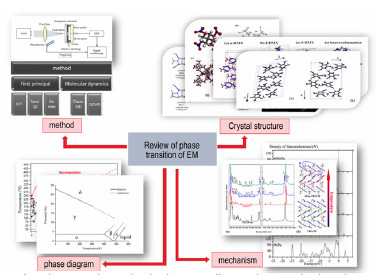
The related research methods that usually used to study the phase transition of energetic materials were reviewed.The commonly used experimental techniques of thermal analysis, ultrahigh pressure and shock loading, as well as many first-principle method and molecular dynamics theoretical simulation research methods with their application scope were introduced. The phase transition characteristics and corresponding phase distributions of some materials under static and shock loading conditions were summarized. The phase transition mechanism revealed by high-precision theoretical simulation investigation of some popular energetic materials was reviewed.





